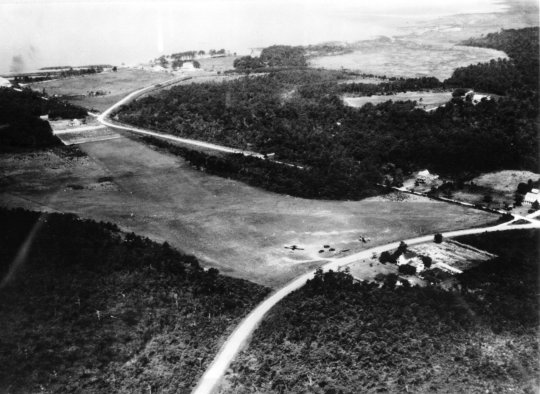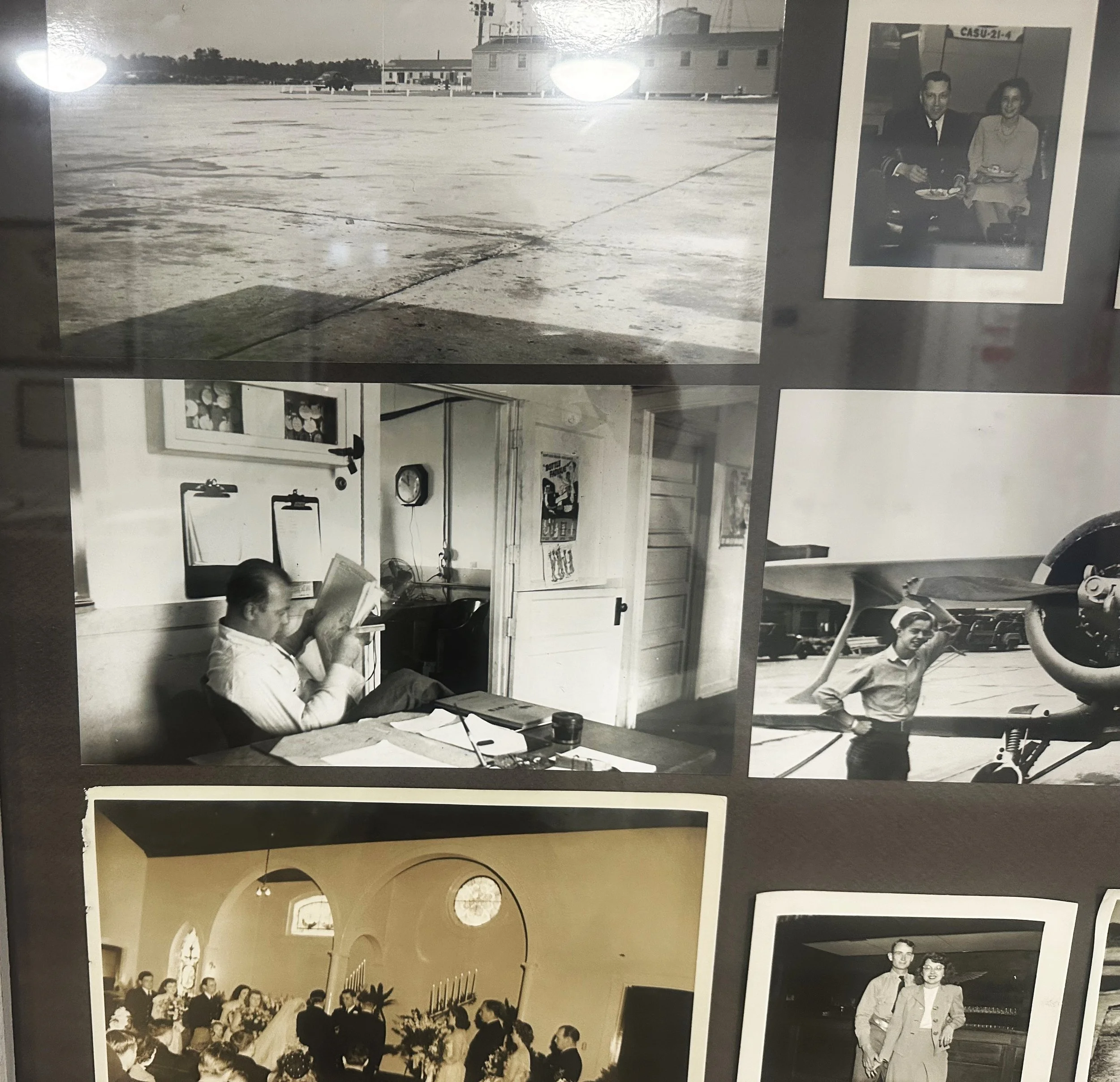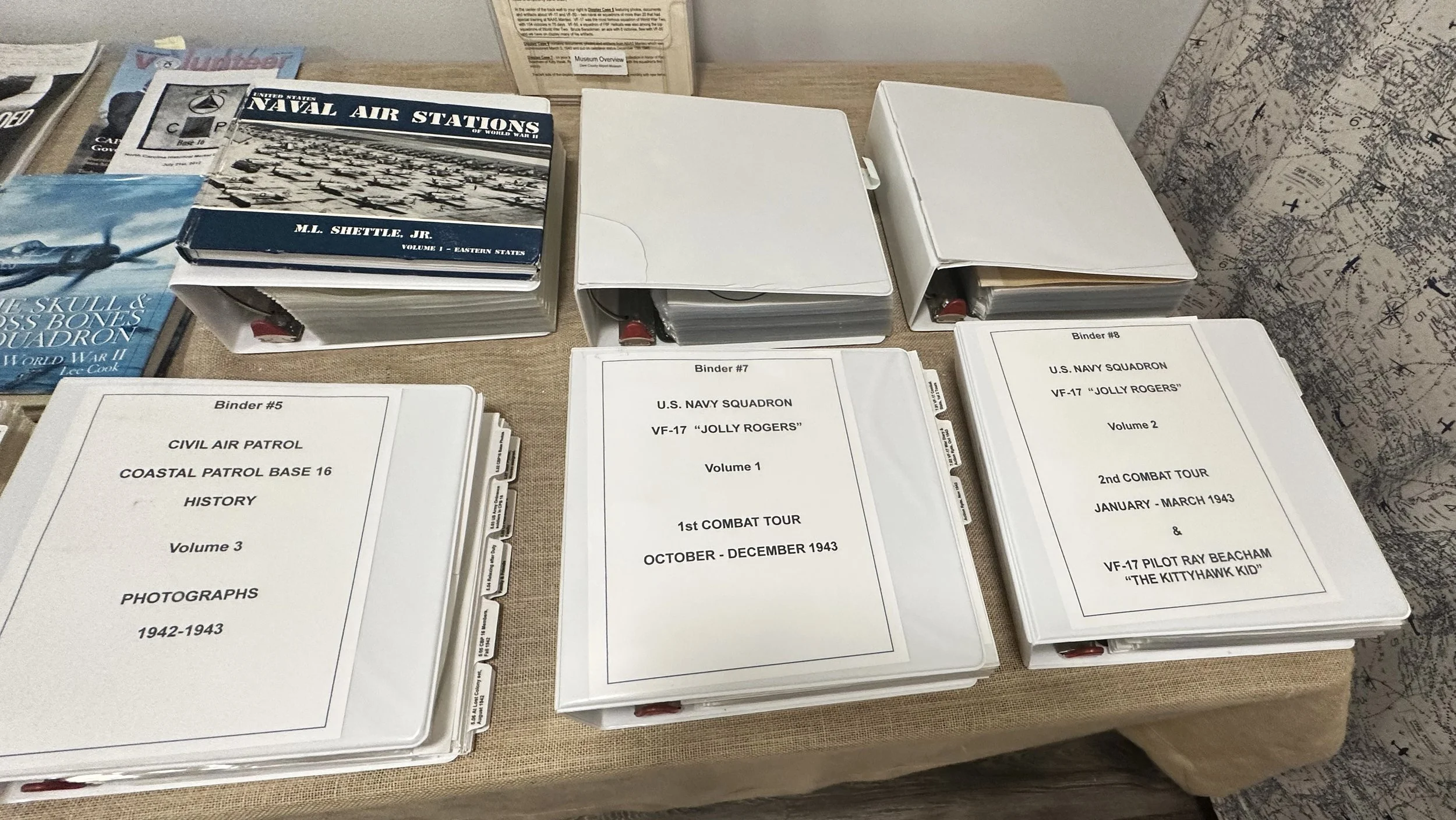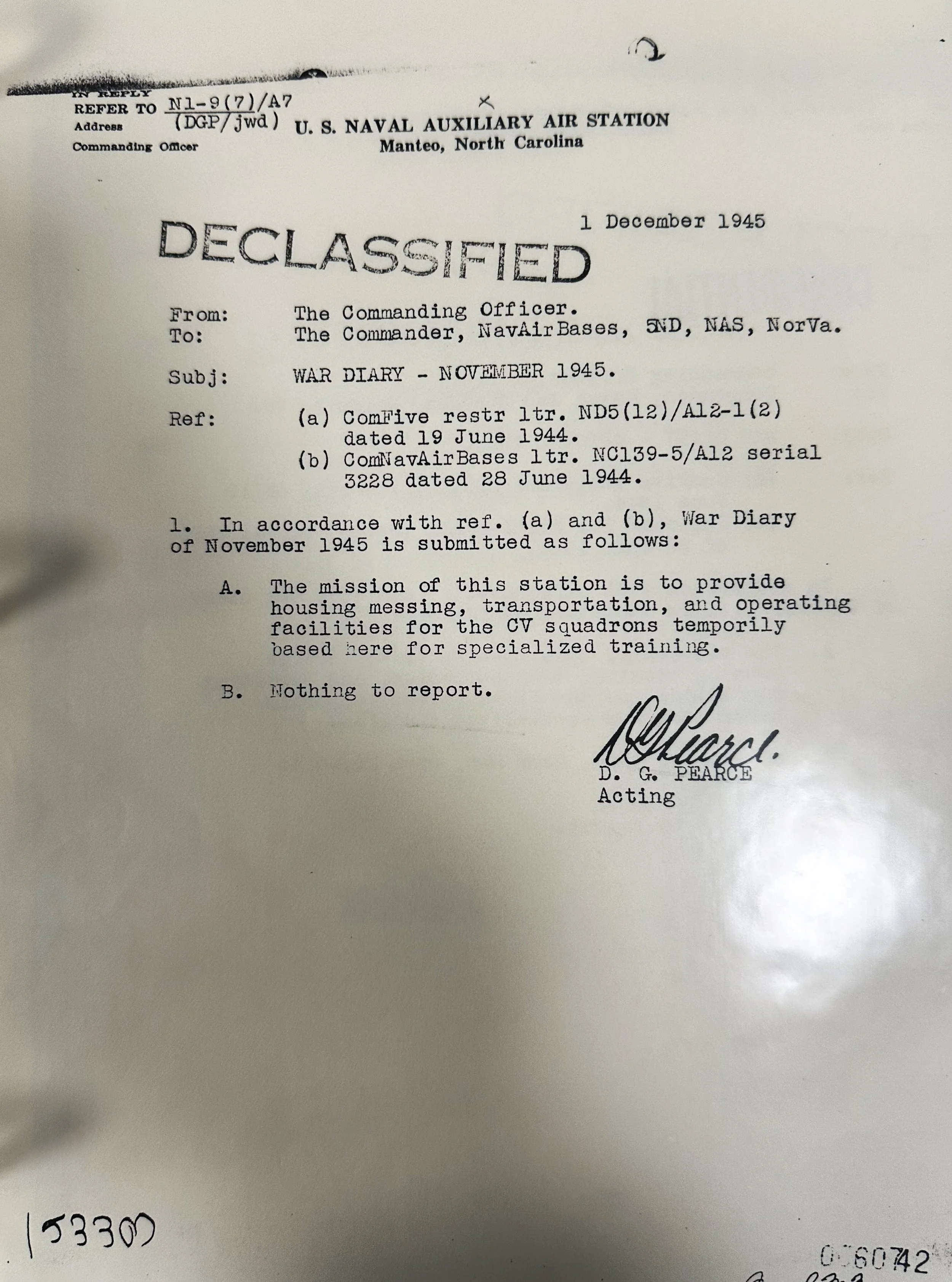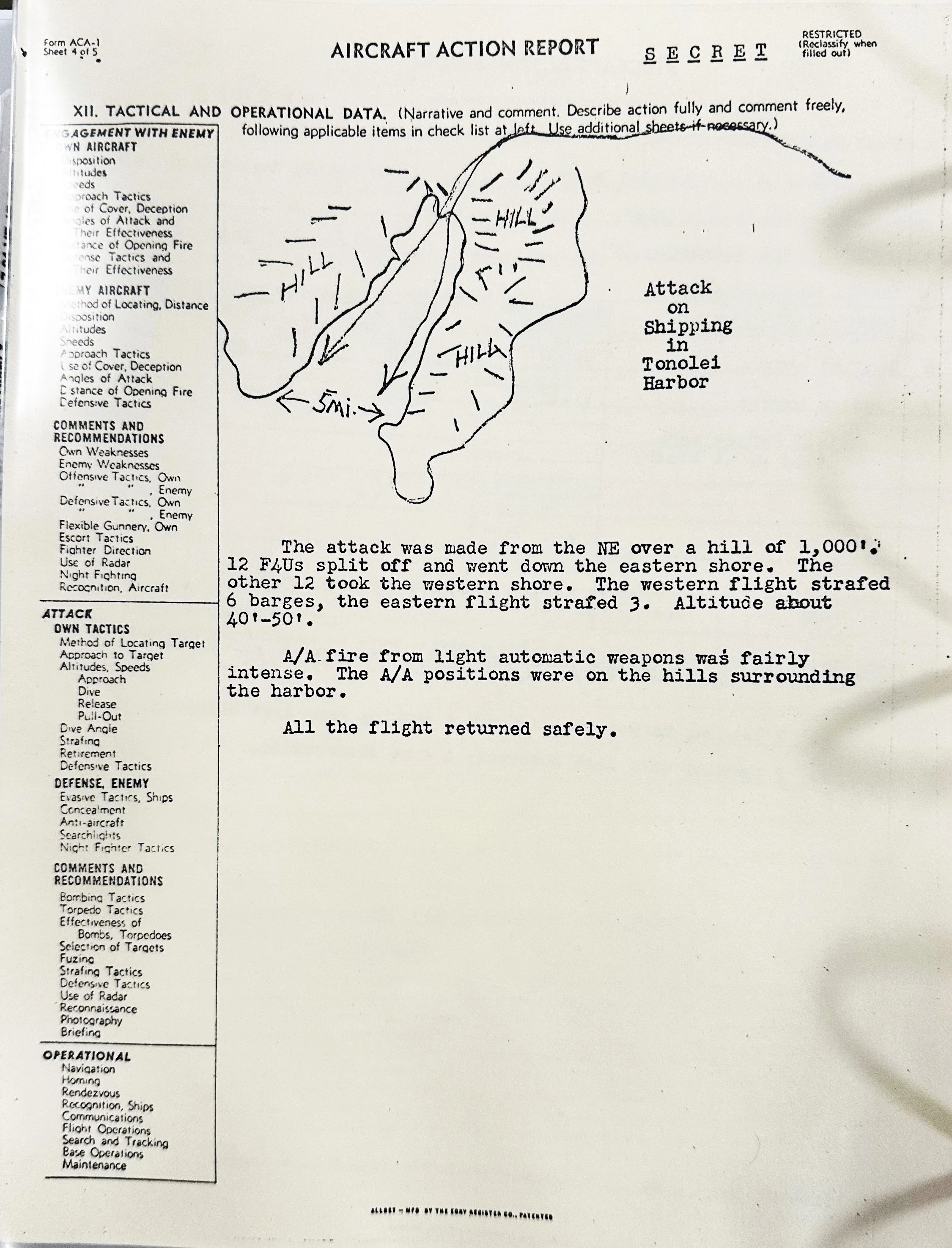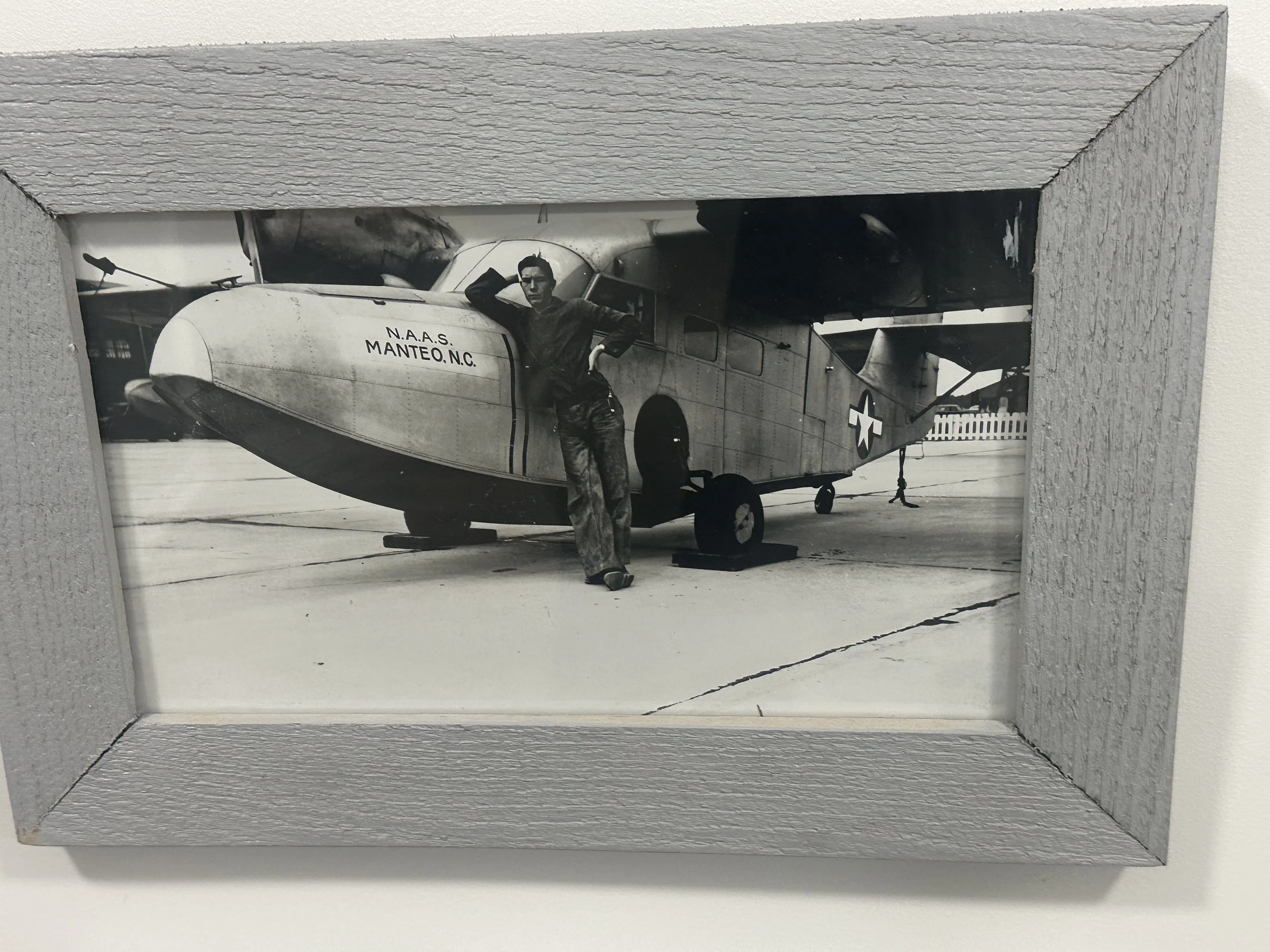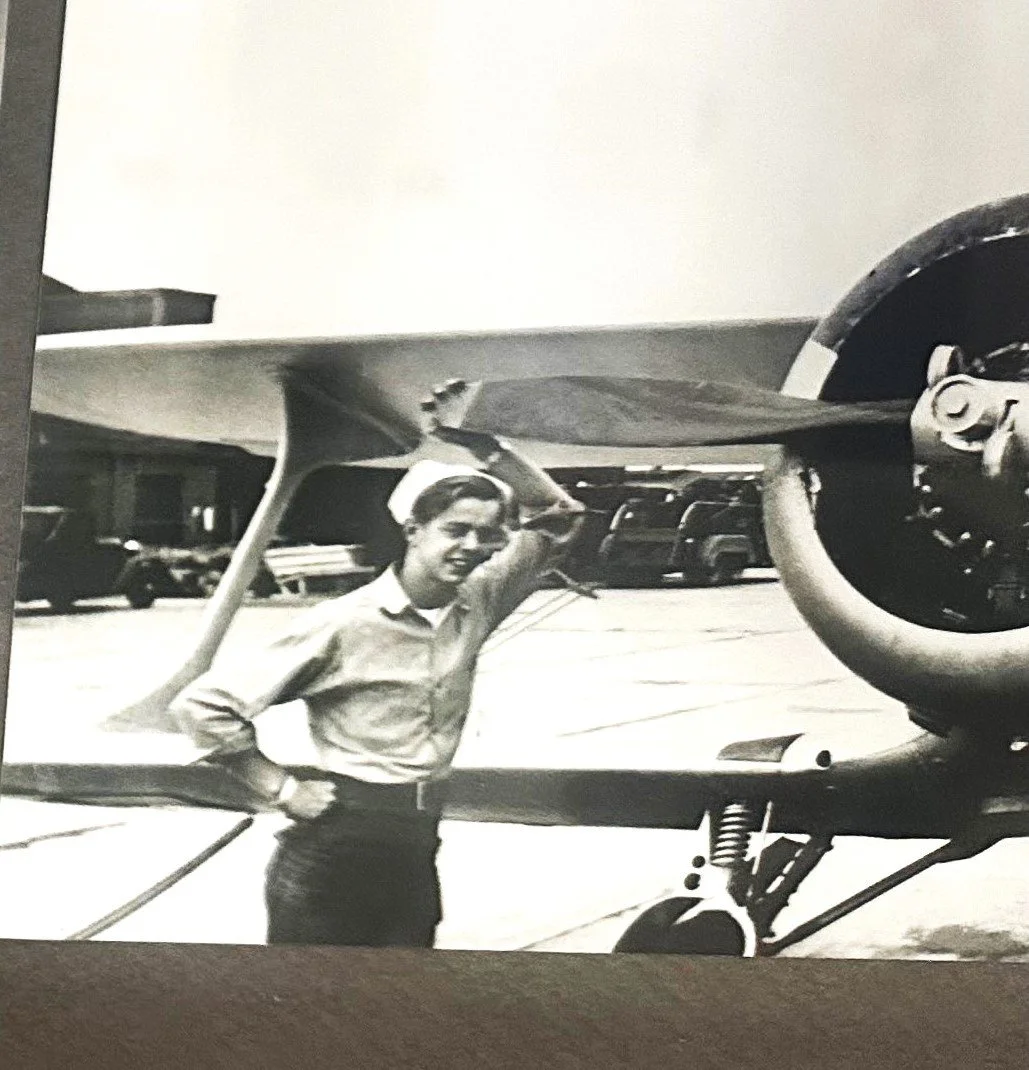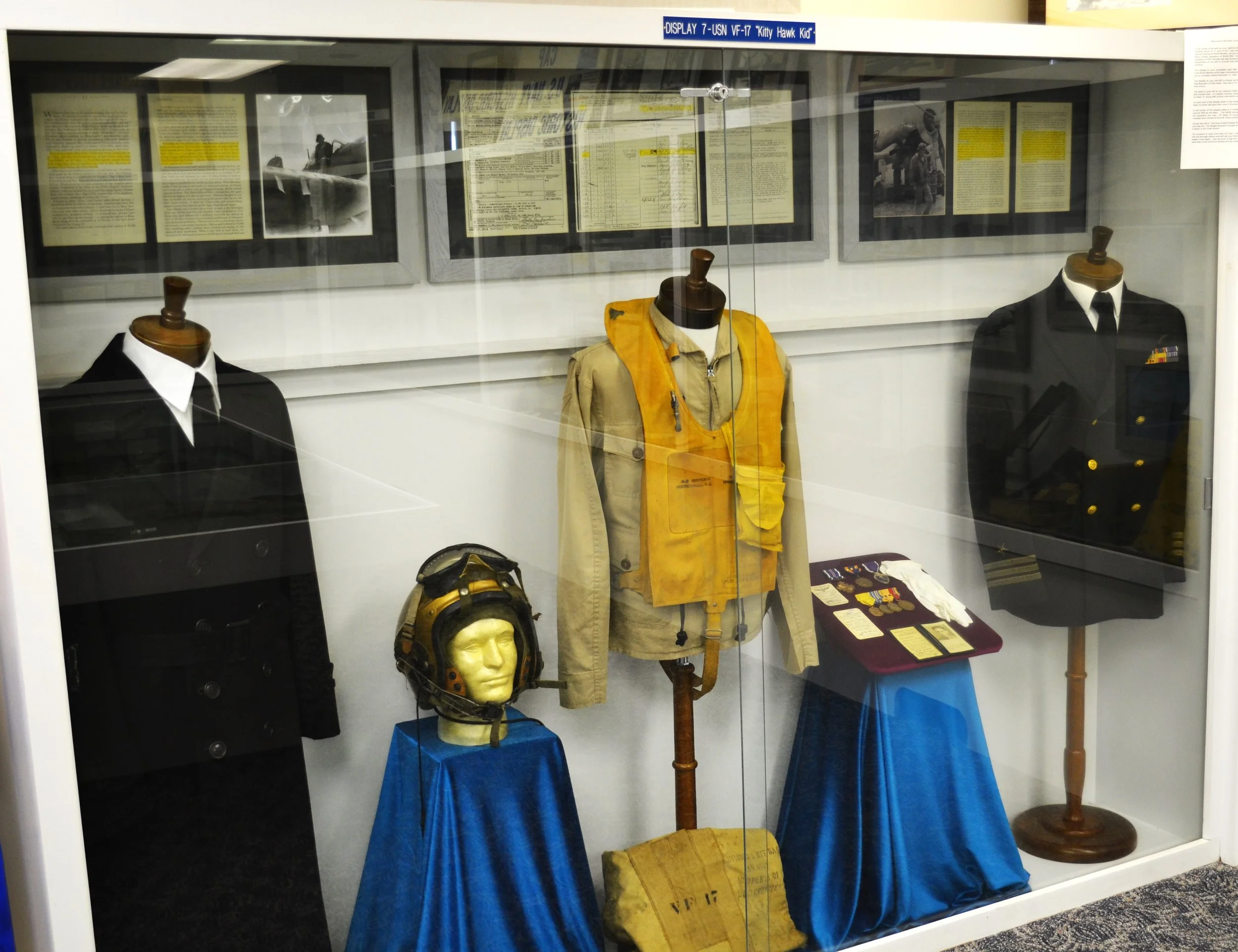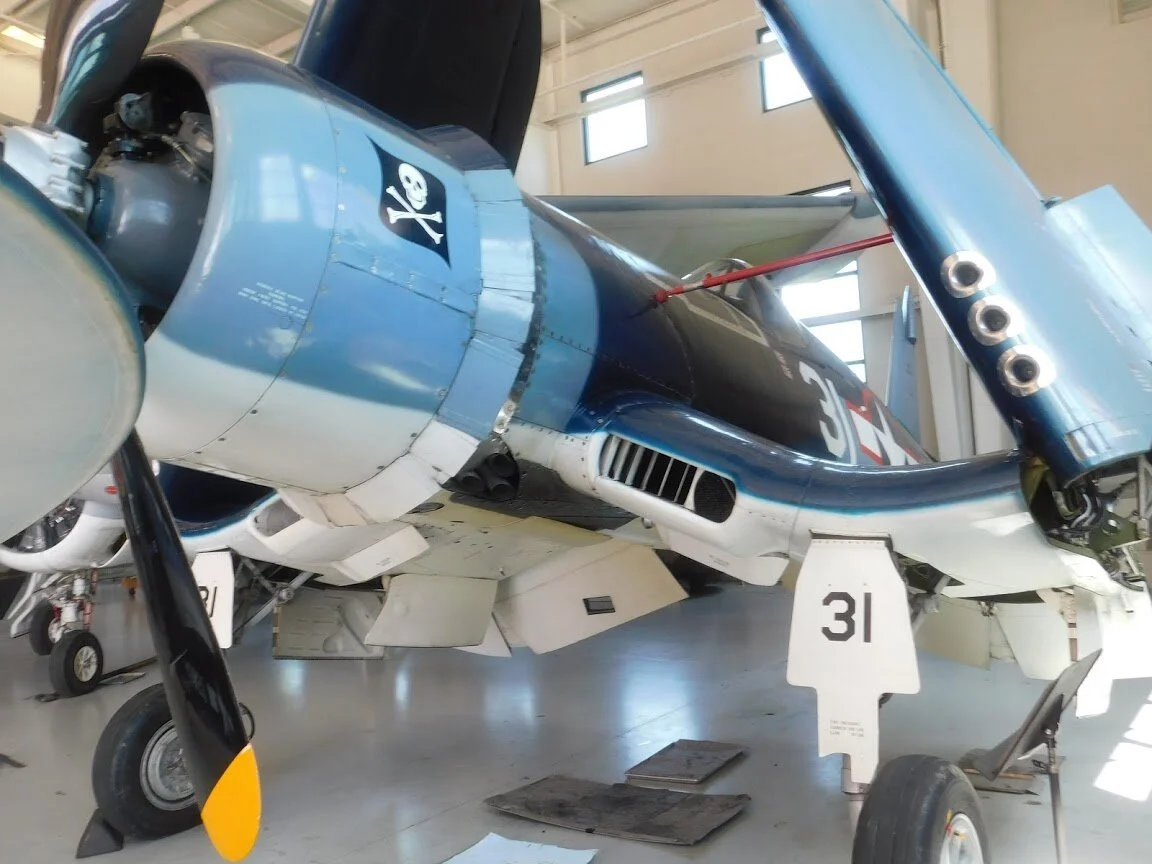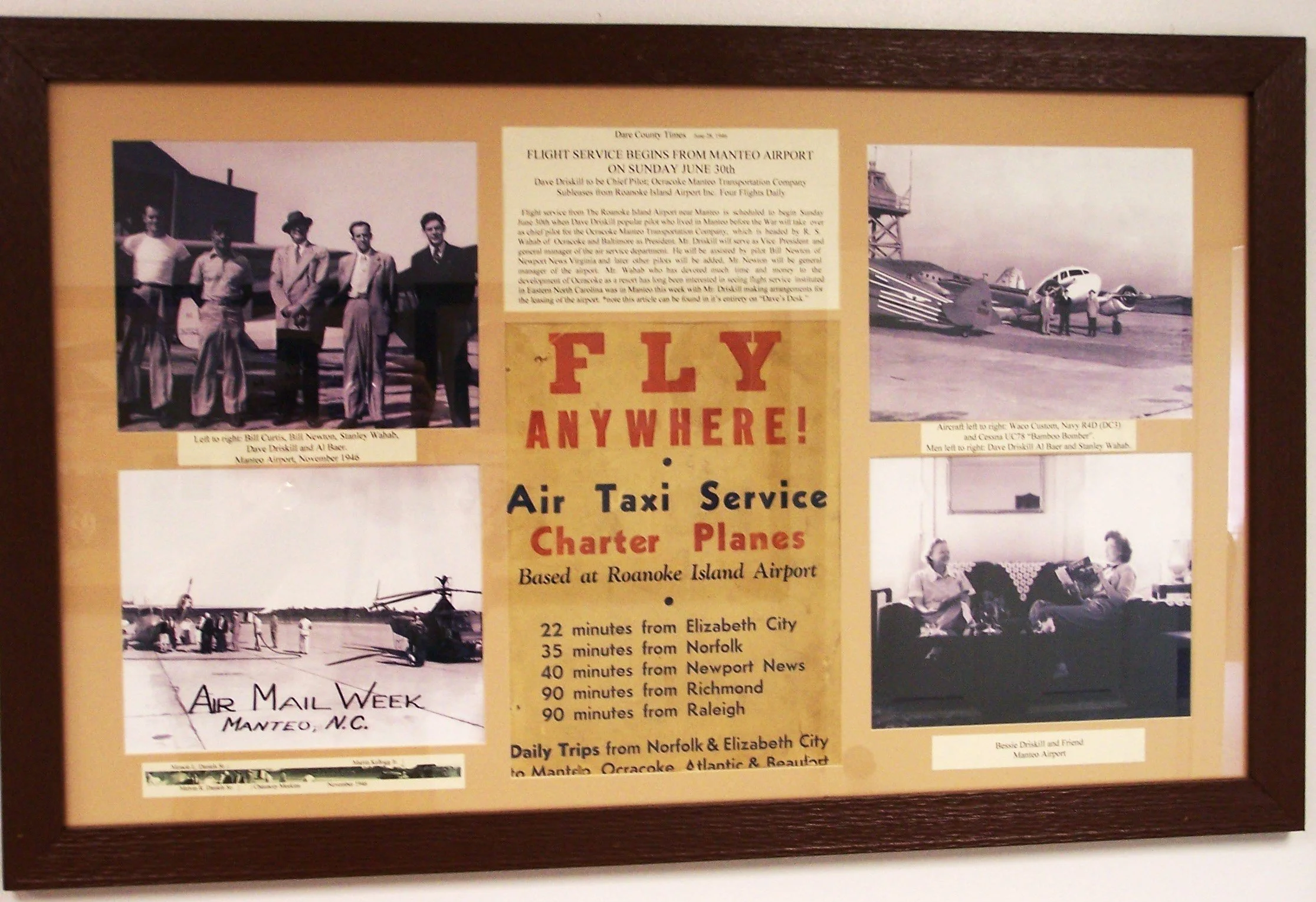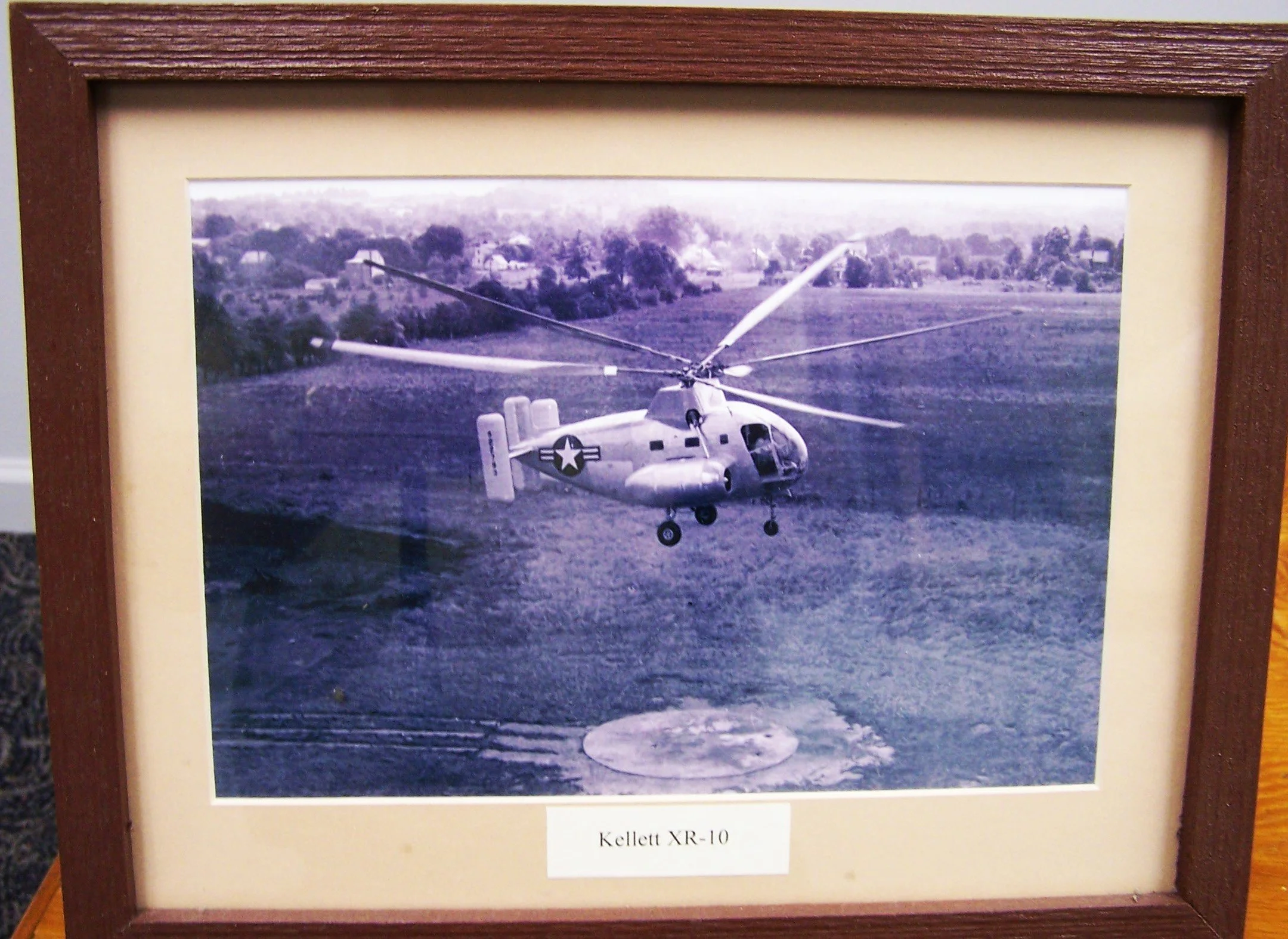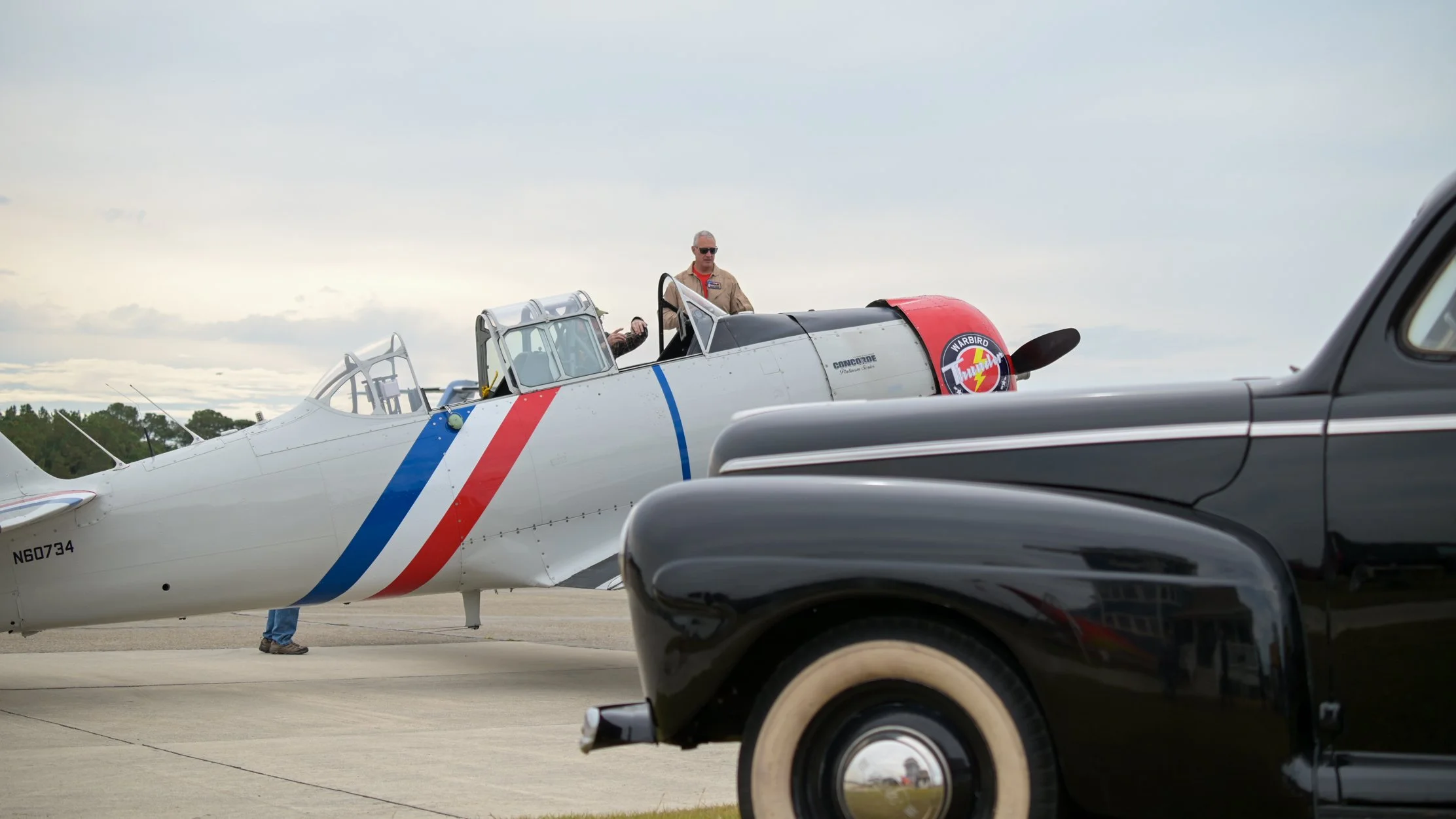Dare County Airport Museum
Part 2
Issue 44 A visit to the Dare County Airport Museum in Manteo North Carolina
The F4U Corsair, piloted by Ensign Howard “Teeth” Burriss, was flying low over a rural two-lane highway in southern Virginia. Burriss caught sight of a speeding tractor trailer aggressively passing cars and causing several to swerve into in a ditch. Burriss, a member of the newly formed Navy fighter squadron VF-17, had been itching to practice his fighter pilot skills and this looked like a great opportunity. He zoomed ahead of the truck, made a 180-degree turn, and headed back toward the semi and its reckless driver- at the same time flipping inverted. When the driver saw the Corsair coming at him at 200 miles an hour- upside down, he drove his tractor trailer into a ditch. This little episode was the final straw for the Commanding Officer of Naval Air Station Norfolk and VF-17 was banished to the wilds of Eastern North Carolina. This set the stage for the story of NAAS Manteo during World War II.
Grumman F4F Wildcat Courtesy of U.S. Navy. Public domain
Norfolk Virginia was a hotbed of activity for the U.S. Navy during World War II. New aircraft were being delivered and new squadrons were forming. In June of 1942, Lieutenant Tom Blackburn was sent to Norfolk from a training squadron in Florida and tasked with forming VGF-29, which would fly Grumman F4F Wildcats. In October of that year, the squadron was deployed on the USS Santee which sailed to North Africa to support Operation Torch. After a few rather unsuccessful missions, Blackburn was ordered to return to Norfolk and stand up another new squadron, VF-17. This squadron would receive brand new Corsairs. Blackburn was able to enlist a few combat veterans for his new squadron but he mainly commanded nuggets right out of flight training. More about VF-17 later.
Vought F4U Corsair Courtesy of U.S. Navy. Public Domain
The Dare County Airport Museum (DCAM) has the mission of telling the long and interesting story of aviation on the Outer Banks in general as well as the specific history of the airport during WWII.
Located on the Northern end of Roanoke Island (the site of the birth of Virginia Dare- the first European born in the New World), Dare County Airport is an interesting local airport that is a bee hive of activity during the summer months.
The museum was founded in 1993 to commemorate the 50th anniversary of the opening of the airport. The founders did an amazing job of collecting original artifacts and over 90% of the items in the museum have a direct connection to the airport during WWII.
Located in the terminal building, the museum has two rooms with the main room dedicated to honoring the Civil Air Patrol and the US Navy. The second room is dedicated to telling the story of Dave Driskill, who was probably the most influential person in developing aviation on the Outer Banks. Issue 36, Part 1 of the Dare County Airport Museum story, told about the early years of Dave Driskill and the beginning of the airport, with the arrival of the Civil Air Patrol.
This second part will tell of the establishment of Naval Auxiliary Air Station (NAAS) Manteo and then return to the post-WWII story of Dave Driskill. But first, a short recap of part 1.
Skyco airport c1940 DCAM Collection
In July of 1942, the North Carolina Wing of the Civil Air Patrol was activated and ordered to the Outer Banks of North Carolina to begin coastal patrols. There was an airport being built on Roanoke Island, but it was not yet open. The CAP was instructed to set up base at Skyco Field, a grass strip located further south on Roanoke Island. Dave Driskill had developed the field in the 1930s and operated his charter service and National Park Service plane there. When the CAP arrived, they immediately set up Patrol Base 16, built a few temporary buildings, and began coastal patrol missions. These missions helped slow down the activities of the U-Boats that had been wreaking havoc off the Coast of North Carolina- the infamous Graveyard of the Atlantic.
By the end of 1942, the new airport was completed and the CAP began migrating their operations, without any break in the missions they were flying. By January 1, the base was fully moved to Dare County Airport.
Dare County Airport, early 1943 DCAM Collection
The Civil Air Patrol quickly established their base on the east side of the new airport, erecting a hangar and building other infrastructure to support the daily operations of Coastal Patrol Base 16. They cut lumber themselves, had it milled in nearby Buffalo City and CAP personnel built the buildings.
On 3 March,1943, NAAS Manteo (pronounced man-e-o) was commissioned as an auxiliary of NAS Norfolk. At this time, the Navy was developing a series of auxiliary training fields throughout the country. These bases were designed to serve as training fields, where squadrons based at major Naval Air Stations (such as NAS Norfolk) would deploy for a short time to conduct exercises in bombing, formation flying, interdiction, and so on. These fields were not intended to be a full-time home, however temporary, for a full squadron. After the antics of VF-17 in the opening story, however, the squadron was ordered to vacate Norfolk. So, in April, Tom Cockburn took his “Jolly Rogers” squadron down the coast to the most isolated field the Navy could find, NAAS Manteo. The Outer Banks was probably a very fitting location for these ‘pirates’ as one of the most famous pirates of all, Blackbeard, had made his home in Ocracoke, on the Outer Banks.
VF-17 quickly established their base in Manteo and got down to some serious training. With no distractions for the young pilots such as those found in Norfolk, the training was very productive. The new CO of the base, a WWI veteran, did not have the energy to discipline his new charges, and they had a free hand. The local residents were of hardy stock, descendants of rugged European settlers, and were little bothered by the day and night flight operations.
Civil Air Patrol Display Cabinets
As you enter the main display room of the museum, you see that the Civil Air Patrol is represented on the right side and the US Navy on the left.
U.S. Navy display cabinets
Each cabinet is filled with a variety of personal items that were donated by the families of people who served at this airport. Items from uniforms, to log books, to photographs, each tell a story about life at the airport during WWII.
Unlike the original CAP base, which was on the other side of the field, the Navy facilities were located right where the museum is now. Once established, the base grew quickly and, by the end of the war, over 1000 people were stationed here. Although no buildings remain from that era, the various aerial photos on display show where everything was located.
NAAS Manteo c1944 DCAM Collection
In the above photo you can see the main building complex on the left. The ramp with aircraft on it is where the parking lot is today and today’s terminal, and museum location, is about in the center of the photo. Airport road, upper left, is mostly in the same location today as it was in 1943. Today it passes by the North Carolina Aquarium, which sits where the barracks and staff buildings were once located. There are still a few concrete pads visible where the buildings stood. The base was built on the North side of the island to accommodate a seaplane base with access to Roanoke Sound. The ramp still exists today as part of a small park, locally known as “the swimming hole”.
One of the great details of this museum are the many photographs the founders gathered that illustrate life at the base and in the surrounding area during the war. The photos capture the more mundane parts of everyday life here. Most aviation museums that are World War II centered concentrate on the aircraft and the pilots who flew them in battle, and rightly so. But for every pilot, there were thousands of people working on the home front to support them. DCAM, in a small way, illustrates and honors those people.
Some of these photos are in the display cases and many more are in the collection of binders that are available for research or just browsing through by visitors.
Documents in the binders range from everyday correspondence to combat action reports.
Most of the photos and documents are from the time in Manteo, but the VF-17 documents extend to their actions in the Pacific Theater.
VF-17 was not the only squadron that set up shop at NAAS Manteo. The museum also has artifacts from VF-50 and other squadrons.
There was a wide variety of aircraft flying in and out of Manteo during the war as well as several assigned to the station, including this Grumman Widgeon. The G-44 Widgeon had its first flight in 1940 and entered service with the US Navy in 1941 for anti-submarine patrol missions. The Widgeon shared the same configuration as the Grumman G-21 Goose, except for being smaller and having two Ranger L-440-5 air-cooled inverted inline six-cylinder engines instead of the radial engines found on the Goose. The Navy purchased 141 Wigeons which were designated the J4F-2.
Although this photo is not captioned, the young sailor is obviously posing in front of a Beechcraft Staggerwing. The Beech model 17 first flew in 1932 and was designed as a fast executive transport. Being introduced during the depression, original sales were slow, but over 400 had been sold by the outbreak of World War II. During the war, a number of these planes were pressed into service in various roles (they were even used as bombers during the Spanish Civil War). Beechcraft built a version for the Army Air Corps, designated YC-43. The Navy designated their Staggerwings GB-1 and GB-2, and around 340 Beech 17s (purchased new or impressed) served in the Navy during WWII.
Let’s return to the story of VF-17. Commanded by lieutenant commander Tom Blackburn, they proved to be the most famous Navy squadron of their time. In their five months of action in the Pacific, the Jolly Rogers shot down 8 Japanese planes for every Corsair lost. In only 76 days of fighting, they flew 8,577 combat hours, destroyed 154 planes (and 5 ships) while losing only 13 pilots themselves. The squadron had 13 aces, more than any other Naval unit. As the tide of the war in the Pacific turned, VF-17 played a big part in demoralizing the Japanese military machine.
Ensign Burris (opening story) became an ace with 7.5 kills and was lost in action in 1944. CO Tom Blackburn was one of the squadron aces with 11 victories. Dare County's own, Lieutenant Sheldon R. "Ray" Beacham of Kitty Hawk, was credited with VF-17s first victory.
As a local hero, Ray Beecham has a place of honor in the museum. A collection of the Kitty Hawk Kid’s Navy memorabilia was donated by his family, including his medals. These include the distinguished Flying Cross, the Navy Air Medal, and the Purple Heart.
The Military Aviation Museum in Virginia Beach honors VF-17 and Ray Beacham with their Corsair, which is painted in the colors of VF-17 (see issue 11 to read about the Military Aviation Museum). This beautiful Corsair, BuNo 92508, is maintained in flying condition.
At the end of World War II, the Navy closed up shop at NAAF Manteo and the airport was returned to Dare County. This return was not simple, and the process is well documented in the museum archives and posted in a binder. In the end, Dave Driskill returned to the Outer Banks and was named the first civilian Director of the airport.
Driskill re-kindled his interest in scheduled commercial service on the Outer Banks. These photos from 1946 illustrate how Dave had quickly fostered growth at the new civilian Airport. (The airport was then called Roanoke Island Airport- a name that was eventually changed to Dare County Airport).
Dave also had continued his association with the Kellett Corporation in Philadelphia and was now their chief test pilot. In 1947, Dave became the first rated helicopter pilot in the U.S.
The story of Dave Driskill ends on a sad note. In 1949, Driskill was test flying the Kellett XR-10 at North Philadelphia Airport when he experienced mechanical issues. The co-pilot successfully bailed out but Dave’s chute got tangled and he died in the fall. Like so many of the brave aviators of early aviation, Dave Driskill died furthering the advancement of aviation.
Several of the museum displays honor the memory of Dave Driskill, including one that contains the parachute that Dave was wearing that fateful day.
——————————————————————
The Dare County Airport Museum is an amazing museum for its size. The displays have basically remained the same since the museum opened in 1993 but there are new initiatives in place to expand the museum and increase its scope. Future additions will cover more of the unique aviation history of the Outer Banks.
As 2023 is the 80th anniversary of its opening, the airport recently hosted a day of celebration, featuring WWII aircraft, historic reenactors, and talks about airport history. Although the event was in November (the original September date was wiped out by a tropical storm), attendance was excellent. Here’s a few photos from the day-
1940 Ford and 1942 SNJ Photo courtesy of Michael Gottwald
Reenactor Lynn Ritger Photo courtesy of Michael Gottwald
Reenactor Theresa Eaman Photo Courtesy of Aviation Photo Journal
Chris Thomas gives a tour of his North American SNJ-2 https://airshow.acchamber.com/project/chris-thomas-airshows/ Photo courtesy of Michael Gottwald
Many thanks to Stacy Ambrose and the Dare County Airport staff who helped put this event together and who keep the museum in good condition, and open it to the public every day of the year.
——————————————————————
To learn about museum hours and costs, as well as books to read and other interesting odds and ends, keep reading!
PLANNING YOUR VISIT
The museum is in the terminal of the Dare County Airport and is open daily from 8 AM to 7 PM. Admission is free.
FLYING IN
Dare County Regional Airport (KMQI) has two runways 05/23 (4300’) and 17/35 (3300’). There are RNAV approaches to 05, 17, and 23. The FBO is in the main terminal with full fuel service as well as rental cars. In the summer, there is a temporary FAA tower and there are a wide variety of activities on the field including banner tow and sky diving.
SUGGESTED READING
“As a dreamer of Dreams and a travellin’ man
I have chalked up many a mile
Read dozens of books about heroes and crooks
And learned much from both of their styles”
Jimmy Buffett (1946-2023) Sail on Jimmy
With the 120th Anniversary of the Wright Brothers first flight approaching (December 17, 2023), I think it’s appropriate to re-visit a few of the hundreds of books written about the Wright Brothers.
Published in 2015, David McCullough’s “The Wright Brothers” is probably the best-known book about the Wrights and is very readable.
Tom Crouch is a retired Wright Brothers expert for the Smithsonian and he has written several books on the subject. “The Bishop’s Boys” is my favorite.
If you are interested in Wright Brothers photography, “Hidden Images”, by Larry E. Tise is a unique close-up look at details of the Wright’s photographs. Tise also recently published the excellent “1903”, a look at life on the Outer Banks during the time of the Wright Brothers visits.
Peter Jakab is another Smithsonian historian who has written several books about the. Wright Brothers. “Visions of a Flying Machine” is a unique approach to the subject, concentrating on their engineering and design process.
The “Wright Brothers” by Fred Kelly (1943) was the only authorized biography of the Wright Brothers and is an interesting read.
WRIGHT BROTHERS STORIES
Note- this is a new section of the blog- a look at some of the many lesser-known Wright Brothers Stories. Two previous sections have been removed to make way- “Where to Eat” and “Local Attractions.” With the help of the internet, these are pretty easy to find, but if a museum recommends anything special, I will still include that information. By the way- if any readers ever visit the Outer Banks, let me know- I’ll be happy to make recommendations- and perhaps offer a guided tour Of the Wright Memorial and the Dare County Airport Museum.
1911 Glider, Kill Devil Hill, NC Public Domain
In October 1911, Orville Wright returned to Kitty Hawk on the Outer Banks of North Carolina. By then, the Wright Brothers were firmly established as world leaders in powered flight. They had a contract with the Army, had sold a number of aircraft in Europe, and they had established a factory and flying school in Dayton, Ohio. Orville, though, remained interested in gliders for research and had gone to Kill Devil Hill that year to test an automatic control system, an early version of an autopilot. The test was cancelled after reporters showed up. Orville, as usual, was concerned about the device becoming public before it was patented. Instead of the test, he decided to see how long his glider could stay aloft. He remained airborne for 9 minutes and 45 seconds, greatly exceeding the Wright’s previous non-powered endurance record. This record would stand for 10 years, and is often considered the beginning of sport gliding.
Note that the glider looks similar to the 1903 Flyer with the exception that the pilot sits upright and the elevator has been moved to the rear. Wing warping was still used for lateral control, even though most other manufacturers were now using ailerons.
MUSEUM WEBSITE
https://www.darenc.gov/departments/airport/history-museum
UP NEXT
The Virginia Air and Space Science Center
MUSEUMS ARE WHERE YOU FIND THEM
This segment is dedicated to finding interesting aviation artifacts that are in public view- but not in an aviation museum. If you see one send a photo!
This replica of a P-51 Mustang sits in front of Hagen Construction in Bensalem PA. I spoke with owner Fred Hagen about the replica and he provided this information-
“The P51 is a full scale model based on my good friend and second father Dave Tallichet's P-51 from which a mold was made and reproduced. If it was a real airplane, it would not be on a pole. Dave was a B17 pilot in the bloody 100th. He owned the B17 Memphis Belle (movie version not the original) and I used to fly the Belle to airshows with David.
I also salvaged the B17 Swamp Ghost out of the Agaimbo Swamp in Papua New Guinea and I filmed a documentary of the same name. The B17 was on loan to the Pearl Harbor Aviation Museum for several years and they have now purchased the bomber.
I also salvaged the Lutz P47 Thunderbolt "Lady in the Clouds" from the Finisterre Range in Papua New Guinea that was sent to Syndey Australia for restoration to flying condition. This P47 was an MIA site. I have searched for and located eight WW2 warbirds that the remains of MIA airmen and returned many for burial with full military honors.”
I look forward to telling more of this story in a future blog.
Thanks to my son Eric for tipping me off about this interesting artifact.
Issue 44, Copyright©2023, Pilot House Publishing, LLC. All rights reserved.
Except where noted, all photos by the author



